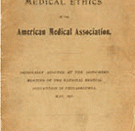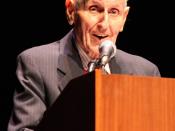Steward Alsop once said, "A dying man needs to die, as a sleepy man needs to sleep, and there comes a time when it is wrong, as well as useless to resist." (Bolander, 1987) Most people in North America die what may be called a bad death. One study found that "more often than not, patients died in pain, their desires concerning treatment neglected, after spending 10 days or more in an intensive care unit" (Horgan, 1996). In these cases the patients, or their doctors, tried to resist death with the aid of modern medicine. One might wonder if there is anything that can be done to help change this grim situation. One possibility is euthanasia. By legalizing the practice casually referred to as "physician-assisted suicide" those who wish to end their lives rather then continue to live in their current condition, will be able to do so.
The word euthanasia was derived from the Greek words eu means "good" and thanatos means "death".
Webster's dictionary defines the word as 'the intentional termination of life by another at the explicit request of the person who dies." That is, the term euthanasia normally implies that the person who wishes to commit suicide must initiate the act. It must be noted that there two main types of euthanasia, passive and active.
Passive Euthanasia is the hastening the death of a person by altering some form of support and letting nature take its course. For example, removing life support equipment, stopping medical procedures and medications, or not delivering CPR and allowing a person, whose heart has stopped, to die? Perhaps the most common form of passive euthanasia is to give patients large doses of morphine to control pain, in spite of the likelihood that the painkiller will suppress respiration and cause death earlier...



Euthanasia
This is a quite well-written essay using a wide variety of sources discussing the pros and cons (mostly the pros) of euthanasia. The only slight constructive criticism I could make is that there was no reference to the only North American jurisdiction allowing physician-assisted suicide--Oregon--and the generally non-controversial (at least in Oregon itself) utilization and application of that law.
7 out of 7 people found this comment useful.